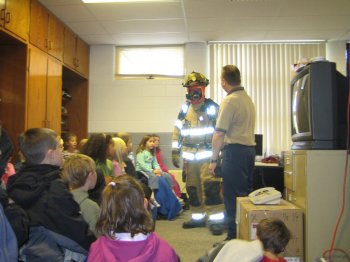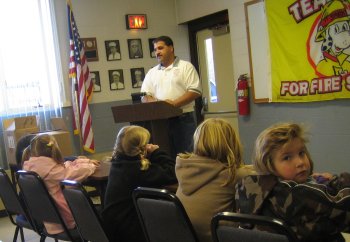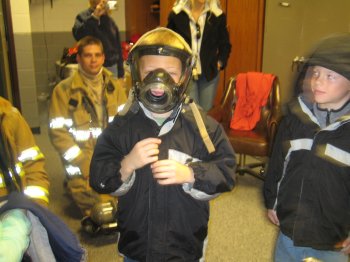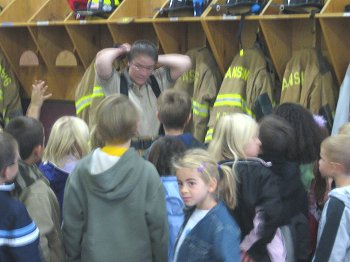- By Dan Veaner
- Around Town
 Print
Print
Last Friday bus loads of second graders descended on Lansing Central Fire Station to learn what fire fighters do, and to learn what they should do when there is a fire. About 15 volunteer fire fighters took the day off of work to show the kids their trucks and equipment, and to talk about what's involved in fighting and preventing fires. "They live the life of a fire fighter for a couple of hours," said Deputy Chief Brad George. "It's to instill fire safety at a young age. Hopefully it will carry on through."

Last year the demonstration had a real consequence when then four year old Blake Hunter saved his house and mom Meredith Sears by putting what he had learned into practice when he awoke to smoke and fire in his house. "If it played a part in helping reduce the severity of her fire, then we did our job," says George. "That proves that it works. And I think kids have a tendency to retain it. They'll probably go back to their parents while eating dinner and say, 'Oh we learned this today.'"

Dan Ferguson and other fire fighters demonstrate a 911 call
The second graders were divided into three groups. In the bunk room Fire Fighter Dan Ferguson explained that some fire fighters live in some of the fire stations, and discussed smoke detectors with the children. Ferguson, a Global history teacher at Lansing High School, had an easy way with the kids, getting them involved in the discussion and using their responses to reinforce his safety message. He had pre-arranged with the 911 center to put a call through so the kids could see that it is not intimidating to call for help.

Deputy Chief Brad George leads a fire prevention discussion
He put the call through on the speaker phone in the bunk room, and it turned out that 911 Dispatcher Cameron is also a Lansing fire fighter who bunks in the station. He told the kids what questions he would ask if they called, and then put through a real signal that goes to fire fighters in an emergency. The children heard the signal a moment later as it squealed through the station speakers and fire fighters' pagers. Three fire fighters crawled into the room in full gear, looking for smoke, fire, and people to rescue.

Patches the Fire Dog
Once the demonstration was done the real fun began. "They really like seeing the fire fighters and going into the bunk room and getting to try on the equipment," says Second Grade Teacher Christine Rebera. "And they talk a lot about the trucks when they get back." Indeed, the children were delighted to try on fire hats and other equipment.
In the training room next door, Chief George had a video to show. He answered questions about the station and the equipment, and got the kids talking about fire safety. Seventh Grade social studies teacher and fire fighter Kim Buck let the third group, letting them go inside two fire trucks, looking at the equipment and sitting in the seats. She showed them how she puts on her fire gear in an emergency.

One of the big hits of the day was Patches the fire dog, a robotic dalmation in a miniature fire truck who quizzed the children on what to do in an emergency. A few children were delighted to notice a fire fighter hiding on a storage balcony, controlling the device and speaking into a headset, but even they were drawn in by the dog's patter and enjoyed running after the little fire truck as Patches led them around the big garage.
Rebera says the second graders prepare for the trip during the week. " We talk about fire safety during Fire Safety Week, and then we have a discussion when we get back," she says. "We practice fire drills. We point things out, and they are very interested, when they get back, to look and find all of the things inside the school. Then they look at home and come back and talk to us about it."

Kim Buck dons her fire fighting equipment
At the end of the event each kid got a fire hat and fire prevention sticker to take home. And some of them had something new to dream about. "A few of them say they want to be fire fighters when they grow up," Rebera says. "Some of them said it before, and usually after we leave someone will say, 'I never thought about it, but maybe I'll do something like that.'" Most importantly, they brought home knowledge of what to do in an emergency.
----
v2i40

Last year the demonstration had a real consequence when then four year old Blake Hunter saved his house and mom Meredith Sears by putting what he had learned into practice when he awoke to smoke and fire in his house. "If it played a part in helping reduce the severity of her fire, then we did our job," says George. "That proves that it works. And I think kids have a tendency to retain it. They'll probably go back to their parents while eating dinner and say, 'Oh we learned this today.'"

Dan Ferguson and other fire fighters demonstrate a 911 call
The second graders were divided into three groups. In the bunk room Fire Fighter Dan Ferguson explained that some fire fighters live in some of the fire stations, and discussed smoke detectors with the children. Ferguson, a Global history teacher at Lansing High School, had an easy way with the kids, getting them involved in the discussion and using their responses to reinforce his safety message. He had pre-arranged with the 911 center to put a call through so the kids could see that it is not intimidating to call for help.

Deputy Chief Brad George leads a fire prevention discussion
He put the call through on the speaker phone in the bunk room, and it turned out that 911 Dispatcher Cameron is also a Lansing fire fighter who bunks in the station. He told the kids what questions he would ask if they called, and then put through a real signal that goes to fire fighters in an emergency. The children heard the signal a moment later as it squealed through the station speakers and fire fighters' pagers. Three fire fighters crawled into the room in full gear, looking for smoke, fire, and people to rescue.

Patches the Fire Dog
Once the demonstration was done the real fun began. "They really like seeing the fire fighters and going into the bunk room and getting to try on the equipment," says Second Grade Teacher Christine Rebera. "And they talk a lot about the trucks when they get back." Indeed, the children were delighted to try on fire hats and other equipment.
In the training room next door, Chief George had a video to show. He answered questions about the station and the equipment, and got the kids talking about fire safety. Seventh Grade social studies teacher and fire fighter Kim Buck let the third group, letting them go inside two fire trucks, looking at the equipment and sitting in the seats. She showed them how she puts on her fire gear in an emergency.

One of the big hits of the day was Patches the fire dog, a robotic dalmation in a miniature fire truck who quizzed the children on what to do in an emergency. A few children were delighted to notice a fire fighter hiding on a storage balcony, controlling the device and speaking into a headset, but even they were drawn in by the dog's patter and enjoyed running after the little fire truck as Patches led them around the big garage.
Rebera says the second graders prepare for the trip during the week. " We talk about fire safety during Fire Safety Week, and then we have a discussion when we get back," she says. "We practice fire drills. We point things out, and they are very interested, when they get back, to look and find all of the things inside the school. Then they look at home and come back and talk to us about it."

Kim Buck dons her fire fighting equipment
At the end of the event each kid got a fire hat and fire prevention sticker to take home. And some of them had something new to dream about. "A few of them say they want to be fire fighters when they grow up," Rebera says. "Some of them said it before, and usually after we leave someone will say, 'I never thought about it, but maybe I'll do something like that.'" Most importantly, they brought home knowledge of what to do in an emergency.
----
v2i40



